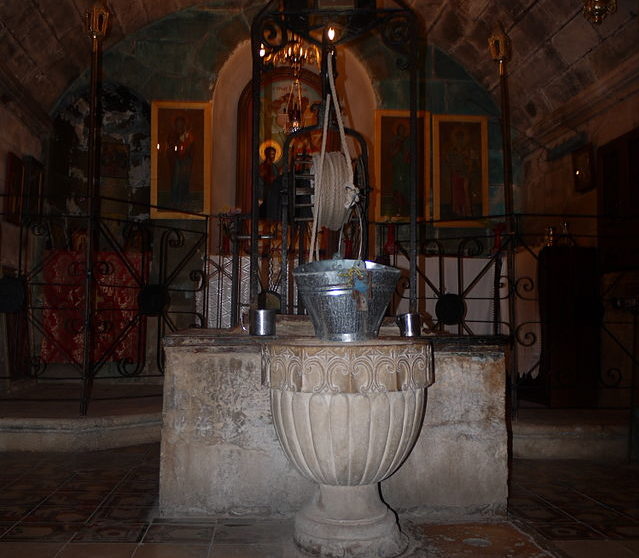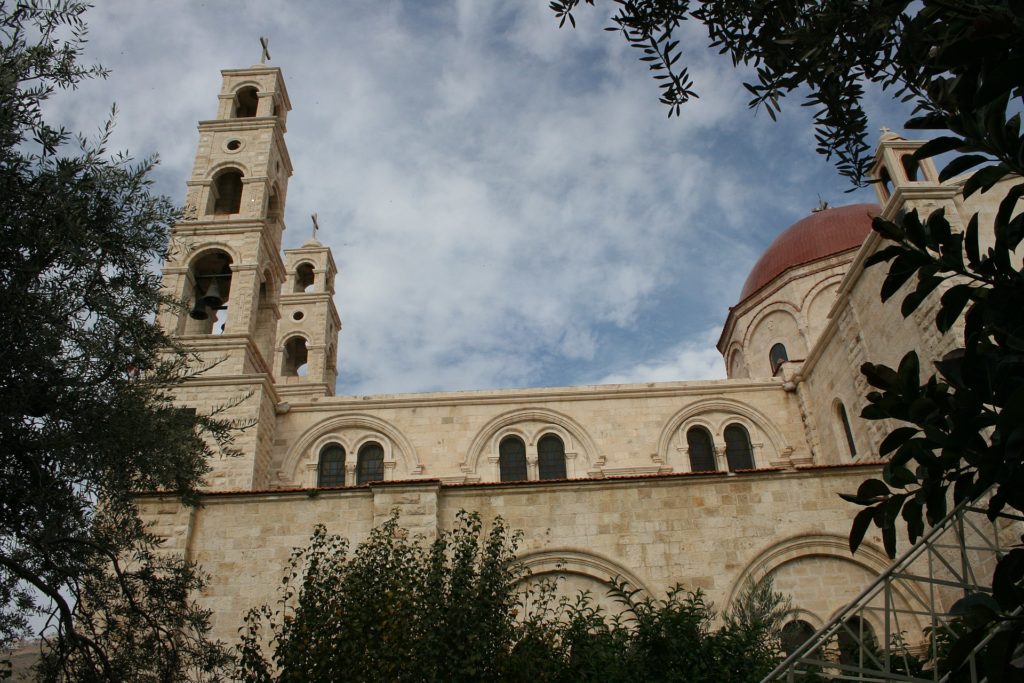
Jacob’s Well, inside the Church of the same name, is a holy Greek Orthodox site that tradition says dates back two millennia and is mentioned in the Book of Genesis. The Well is located in the West Bank, the smaller of the two Palestinian territories.
According to the Bible scholars, when Jacob returned to Shechem from Paddan-aram, he camped “before” the city and bought the plot on which he pitched his tent. They contend that this is the place where Jacob’s Well was built.
There is also a mention by name in the New Testament’s Gospel of John (4:5f), where it is recorded that Jesus “came to a city of Samaria, called Sychar, near the field which Jacob gave to his son Joseph. Jacob’s well was there.”
Also known as Jacob’s fountain, Well of Sychar and Φρέαρ του Ιακώβ in Greek, it is a pilgrimage site revered by the Christian, Jewish, and Muslim faiths.
The well is 41 meters deep (135 feet) and can be accessed by entering the Church, and descending the stairs to a crypt containing the well by a small winch and a bucket.
The History of the Greek Orthodox Church of Jacob’s Well in Palestine
For the Greek Orthodox church the religious significance of the Church of Jacob’s Well lies to the fact that it was built on the land where Jesus Christ revealed for the first time that He is the Messiah.
John’s Gospel describes a conversation between Jesus and a Samaritan woman. The conversation took place while Jesus was resting at the well after a tiring journey.
Jacob’s well was there; so Jesus, wearied as he was from his journey, was sitting beside the well. It was about the sixth hour.
A woman from Samaria came to draw water. Jesus said to her, “Give me a drink.” (For his disciples had gone away into the city to buy food.)
The Samaritan woman said to him, “How is it that you, a Jew, ask for a drink from me, a woman of Samaria?” (For Jews have no dealings with Samaritans.) Jesus answered her, “If you knew the gift of God, and who it is that is saying to you, ‘Give me a drink,’ you would have asked him, and he would have given you living water.”
The woman said to him, “Sir, you have nothing to draw water with, and the well is deep. Where do you get that living water? Are you greater than our father Jacob? He gave us the well and drank from it himself, as did his sons and his livestock.”
Jesus said to her, “Everyone who drinks of this water will be thirsty again, but whoever drinks of the water that I will give him will never be thirsty again. The water that I will give him will become in him a spring of water welling up to eternal life.”
The woman said to him, “Sir, give me this water, so that I will not be thirsty or have to come here to draw water.”
Jesus said to her, “Go, call your husband, and come here.” The woman answered him, “I have no husband.” Jesus said to her, “You are right in saying, ‘I have no husband’; for you have had five husbands, and the one you now have is not your husband. What you have said is true.”
The woman said to him, “Sir, I perceive that you are a prophet. Our fathers worshiped on this mountain, but you say that in Jerusalem is the place where people ought to worship.”
Jesus said to her, “Woman, believe me, the hour is coming when neither on this mountain nor in Jerusalem will you worship the Father. You worship what you do not know; we worship what we know, for salvation is from the Jews. But the hour is coming, and is now here, when the true worshipers will worship the Father in spirit and truth, for the Father is seeking such people to worship him. God is spirit, and those who worship him must worship in spirit and truth.”
The woman said to him, “I know that Messiah is coming (he who is called Christ). When he comes, he will tell us all things.”
Jesus said to her, “I who speak to you am he.”
(John chapter 4)
The jar of water carried by the Samaritan woman exists today, preserved in a glass frame, while a small relic is preserved in a glass frame on top of one of the pillars inside the Church.
The story of the Church of Jacob’s Well in Palestine dates back to 16 centuries ago. The first church was built by St. Helen in the fourth century, but the the church was demolished in the fifth or sixth century by the leaders of the Samaritan rebellion.
It was rebuilt by the Byzantine Emperor Justinian I and was standing in 720 or possibly until the 9th century. When the Crusaders arrived in the early 12th century it was in ruins.
A third attempt to build the Church of Jacob’s Well was made by the Crusaders in 1172 but it was again demolished after their defeat by Saladin in the Battle of Hattin 1187.
From the 12th century and on, the site was in ruins but the well was still there. However, Christians continued to visit and worship the site. In 1860 the Bishop of Gaza purchased the site and returned it to the Jerusalem Greek Orthodox Patriarchate.
Between 1893 and 1908 the Church of Jacobs Well was built, albeit incomplete, along with a small monastery. A Jericho earthquake caused great damage to the church and the monastery in 1927.

Modern Era Contention over Jacob’s Well
By 1979 the Greek Orthodox Church of Jacob’s Well in Palestine was still incomplete. At the time, the West Bank was occupied by the Israelis and there was contention between the Christians and the Jews over the church.
Reportedly, in November 1979 a Zionist group went to the monastery claiming it as a Jewish holy place and demanding that all religious iconography be removed.
A week later, an assailant intruded the monastery and threw a hand grenade killing several people and causing severe damages to the monastery.
After that, he went inside the crypt housing the well and killed the custodian of the well, Archimandrite Philomenos, repeatedly hitting him with an axe.
Three years later, the assailant was apprehended and confessed the murders. According to a Jerusalem Post report the 37-year old he was a mentally ill resident of Tel Aviv.
The man confessed to the slaying of Archimandrite Philomenos and others, including an assault on a nun at the monastery and the axe murder of a Jewish psychiatrist in Tel Aviv.
Archimandrite Philomenos was canonized a Saint by the Greek Orthodox Church in
2009. His Holy relics are kept in a reliquary inside the Church.
The Church of Jacob’s Well in Palestine Today
In 1980, after the martyrdom of St. Philomenos, Father Ioustinos was sent by the Patriarchate to serve the Church of Jacob’s Well, with the goal to complete its building.
After facing many obstacles, Father Ioustinos was finally granted the permission by
then Palestinian President Yasser Arafat to continue the building of the Church, as an honor for his help to the Palestinians.
Father Ioustinos worked on every aspect of the Church, from collecting donations for the construction to painting the icons. It took him 11 and a half years to finish the Church inside out.
During those years he was exposed to repeated aggression and violent attacks and numerous attempts of theft and destruction of the Church, but he refuses to back down.
Today, a significant amount of pilgrims arrive to the Church of Jacob’s Well every year, and the site has also become a tourist attraction in the West Bank area.
See all the latest news from Greece and the world at Greekreporter.com. Contact our newsroom to report an update or send your story, photos and videos. Follow GR on Google News and subscribe here to our daily email!



